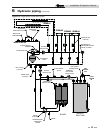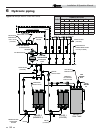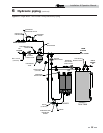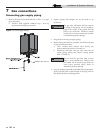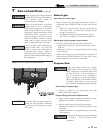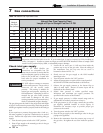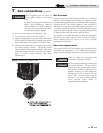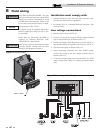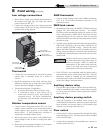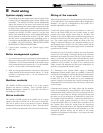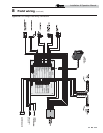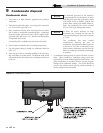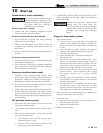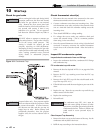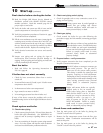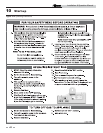
Installation & Operation Manual
41
Low voltage connections
1. Route all low voltage wires through the knockouts in
the bottom front right side, just under the control
panel, as shown in FIG. 8-3.
2. Connect low voltage wiring to low voltage connection
board as shown in FIG. 8-4 on page 43 of this manual
and the boiler wiring diagram.
LOW VOLTAGE
WIRING KNOCKOUTS
LOW VOLTAGE
CONNECTION BOARD
LINE VOLTAGE
WIRING KNOCKOUTS
LINE VOLTAGE
JUNCTION BOX
Figure 8-3 Routing Field Wiring
8 Field wiring (continued)
Thermostat
1. Connect the room thermostat or end switch (isolated
contact only) to terminals R and W, as shown in
FIG. 8-4.
2. Install the thermostat on the inside wall away from
influences of drafts, hot or cold water pipes, lighting
fixtures, television, sunlight, or fireplaces.
3. Thermostat anticipator (if applicable):
a. If connected directly to boiler, set for 0.1 amps.
b. If connected to relays or other devices, set to
match total electrical power requirements of
connected devices. See device manufacturers’
specifications and thermostat instructions for
details.
Outdoor temperature sensor
1. Connect outdoor temperature sensor (FIG. 8-4) to the
outdoor sensor terminals on the connection board to
enable outdoor reset operation of the Knight wall
mount boiler. If fixed temperature operation is
required, do not install outdoor sensor.
2. Mount the sensor on an exterior wall, shielded from
direct sunlight or flow of heat or cooling from other
sources.
3. Route sensor wires through a knockout in the bottom
front right side of the boiler (see FIG. 8-3).
DHW thermostat
1. Connect storage indirect water heater (DHW) thermostat
(FIG. 8-4) to the DHW thermostat terminals on the
connection board.
Auxiliary device relay
1. If an auxiliary device needs to operate when the boiler fires,
it can be controlled by this output. Connect these terminals
to a 24 vac relay coil, which is wired to operate the auxiliary
device (FIG. 8-4).
Auxiliary device proving switch
1. When the operation of an auxiliary device needs to be
verified before the boiler fires, remove the jumper wire from
these terminals and connect them to the normally open
contacts on its proving switch (FIG. 8-4).
Flow switch
1. A flow switch is used to guarantee flow through the boiler
before allowing it to fire. The flow switch must be installed
in line with the boiler.
2. Connect these terminals to the normally open contacts on
the flow switch (FIG. 8-4).
DHW tank sensor
1. By installing a tank sensor, the SMART SYSTEM control can
perform the tank thermostat function. The SMART
SYSTEM control automatically detects the presence of this
sensor and generates a DHW call for heat when the tank
temperature drops 6°F (3°C) below the tank set point and
finishes the call for heat when the tank temperature reaches
the tank set point.
2. The tank sensor included with the Lochinvar Squire Indirect
DHW tank (TST2032) is the only sensor suitable for use
with the SMART SYSTEM control. Connect the sensor
leads to the DHW Tank Sensor (AUX) terminals on the Low
Voltage Connection Board. Consult the tank manufacturer
for application and performance when used with any other
indirect tank.
Failure to use the correct sensor may result in
the tank temperature being either above or
below the set point. Failure to consult the
manufacturer of the indirect tank, when the
Squire is not used, may result in decreased
performance or the risk of scald injury.
ƽ WARNING
3. If the TST2032 is not compatible with the indirect tank, a
tank thermostat can be used to control the boiler. The tank
thermostat should be installed per the manufacturers
instructions and wired to the DHW Thermostat terminals
on the Low Voltage Connection Board.



